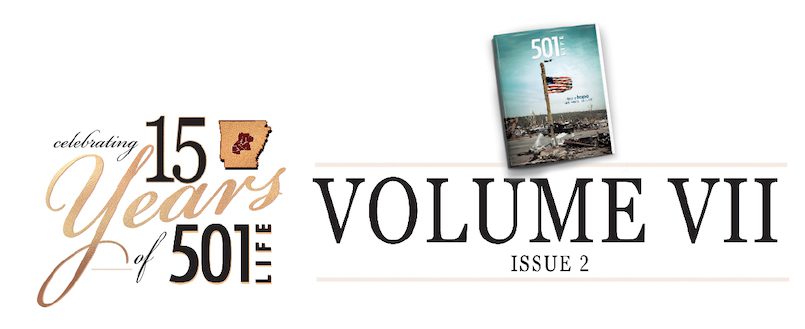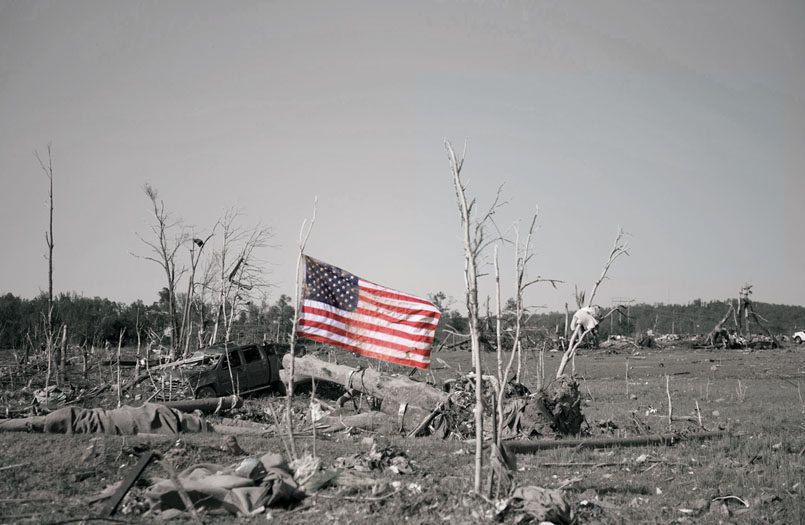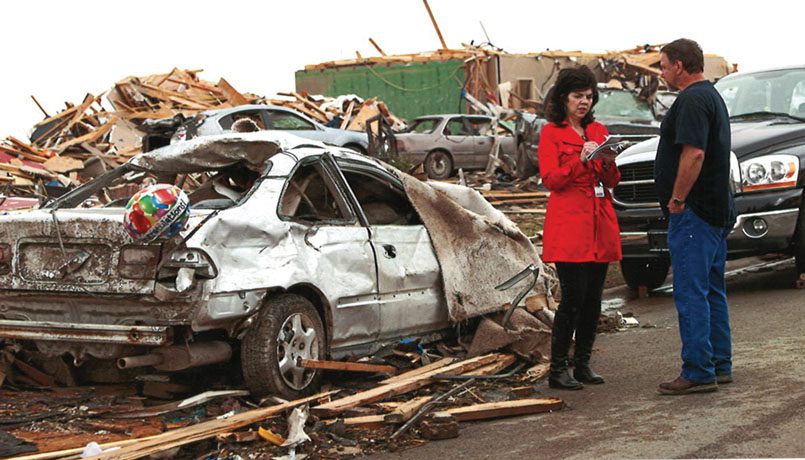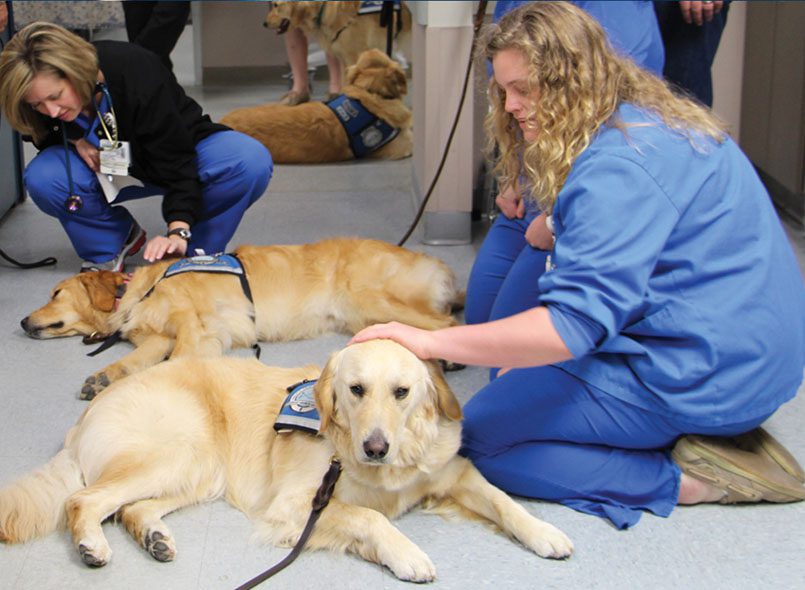02 Apr 2023 Standing again after the storm

By Tammy Keith
Someone driving through Vilonia will see an active small town with new homes and thriving businesses, manicured ballfields and well-kept schools. What they don’t know is how much residents had to lose to get there.
Vilonia still had scars from a deadly 2011 tornado when an even-stronger storm ripped through the city on April 27, 2014, and killed eight residents. The twister that hit Vilonia that Sunday evening also destroyed the district’s $13 million intermediate school that was three months away from opening; leveled homes, blowing memories miles away, and decimated the heart of Vilonia’s downtown, knocking out 70-80 percent of businesses, said then-Mayor James Firestone, who is now a City Council member.

“Almost all our businesses are gone. How do you recover from that?” he asked at the time, as he surveyed the surreal scene.
Today, he knows the answer.
“We dug in, packed up, picked up, pulled ourselves up by our bootstraps,” Firestone said. Not that they didn’t need and want help.
The Federal Emergency Management Agency, Army National Guard, Vilonia Disaster Relief Alliance, fire, law enforcement, churches, and multiple organizations aided Vilonia. “FEMA made low-interest loans. The cleanup was a big deal,” Firestone said.
Rebuilding didn’t happen overnight, though.
“For several years, we were stagnant, no growth to speak of. We were hurting and still cleaning up. By 2018, we were starting to come back,” Firestone said.
Harps grocery store rebuilt where a strip mall was destroyed; Vilonia United Methodist Church was torn down and rebuilt; ballfields were repaired with FEMA money; sidewalks and lights were installed downtown. “It was neighbors helping neighbors. When we went out and did the survey of damage, people were on their own cleaning, helping each other,” he said. There were 167 structures declared a “total loss.”

Kieth McCord, owner of Kieth’s Texaco, barely stopped to take a breath after the tornado that gutted his business. The next day, he put portable garages on the remaining slab and provided oil changes and fixed flats for residents and first responders who had driven over nails among the debris.
“We needed him, and Kieth came to the rescue,” Firestone said. “People like that just dug in and said, ‘We’re not going to give up; we think we’re going to make it.’”
McCord said it took two years to build his business back, but it’s “bigger and better.” With the tornado came opportunity, too. “We have new things and new buildings and a clean slate to build from. Being a small town, for sure people get together when it’s time. When things get bad, people help each other. People would help clean up, or bring water. It’s just one more obstacle in life. You just jump over it and keep on trucking.”
Tommy Bates, who owns Vilonia Therapy Services, lost the home his family was renting, his truck and their new business. Theirs was one of 55 of 56 homes in Parkwood Meadows that was destroyed. At the time, Bates said he felt lucky, because two of his neighbors lost their lives, including 31-year-old Master Sgt. Daniel Wassom II. His widow donated their lot to the city to create a park, and it’s dedicated to Wassom and the other seven victims: Jamye Collins, 50; Jeffrey Hunter, 22; Dennis Lavergne, 52; Glenna Lavergne, 53; David Mallory, 57; Cameron Smith, 8; and Tyler Smith, 7.
Bates and his wife, Susan, rebuilt their business at its original location on Main Street, and it is thriving, he said.
“Where we are today is proof of God’s faith, and we’re very grateful for the support of the community,” he said. Bates said the hard-hit neighborhoods stayed bare and school enrollment sagged for a time, but he saw the pieces start to fall in place about 2 ½ years ago. “I still hope and believe the best is yet to come,” he said.
Cathy Riggins, assistant superintendent for the school district, remembers finding out the intermediate school under construction had been hit.
“I think the first thing I was so grateful for was that it wasn’t a school day that students were in attendance,” she said. “I didn’t know the magnitude till I was able to go to the site. My heart just sank. I’d never seen anything like that in my lifetime.”

Nothing could be salvaged, so construction started over. Riggins said that allowed contractors to improve the design, and FEMA provided a $1 million grant for a safe room on the campus.
“One of the things that changed since that last tornado, … we can probably get all our students in our district and ABC (Arkansas Better Chance Preschool) students in a safe room within 15 minutes. We have a plan in place,” she said. “We’ve learned not to live in a culture of fear but to be aware and prepare ahead of time.”
Andy Pennington, principal of the 665-student Frank Mitchell Intermediate School, said it’s more than a building.
“I think if anything, the school is just a symbol of the community’s resilience and unwillingness to stop everything for something that is out of our control. We’re not going to let a tornado stop us. The school in essence is showing, ‘You can knock us down, but we’re still going to be here and we’re going to come back.’”
Riggins said Vilonia is “coming back,” and she gave credit to Vilonia Mayor Preston Scroggin for seeking grants to beautify downtown.
Scroggin, who is in his fifth year as mayor, also had his life uprooted by the tornado. “Our entire farming operation got destroyed — 128 head of cattle, all our equipment, 13 barns,” he said. His home was gone, too. “It was leveled, taken to the slab.” He built back in the same spot. “I look at my personal life and the town of Vilonia — it’s been an amazing rebound. God’s hand’s been upon us all. Our farm is back bigger and better than before,” Scroggin said.
He praised Firestone, the City Council at the time and the city employees.

“We just have an amazing group of business leaders, an amazing group of residents and an amazing staff, and they just weren’t going to let a tornado whip them. [The city] is cleaned up now, and you can’t really tell. Time heals all wounds,” he said. “I’m really proud of where our little town is.”
The population of Vilonia is estimated at 4,450, according to Metroplan Interim Director Casey Covington. “It’s one of the fastest-growing cities since 2020,” he said. Scroggin said Vilonia has room for more — 200 subdivision lots are coming online next year.
Firestone said Vilonia residents are loyal. “That’s what really impressed me most. People have roots here. We built a storm shelter; I’m not moving. We’ve had two tornadoes; unfortunately, they were three years apart. … There are things we have to deal with because of Mother Nature. I’ve had people say, ‘Well, I’d move.” I say, ‘Why?’ To me, it’s the place, the people — that says it all. We care about our neighbors; we care about our people; we care about our city. That’s what makes Vilonia a special place.”
And you can’t keep a good town down.











